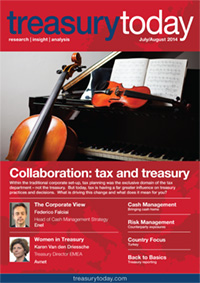Contents
- Editorial
- E-invoicing gains momentum
- Women in Treasury
- Karen Van den Driessche, Avnet - Women in Treasury
- Question Answered
- M&A activity
- Market View
- Rising interest rates as central banks seek higher inflation
- Adam Smith Awards
- The triumph of treasury
- Insight & Analysis
- Tax and treasury: working together
- Country Focus
- Turkey: land of opportunity?
- Risk Management
- Counterparty risk: know your limits
- The Corporate View
- Corporate View: Federico Falciai, Enel
- Cash Management
- Working my way back to you
- Careers
- Just the job
- Back to Basics
- Treasury reporting
Editorial
E-invoicing gains momentum
It’s been a busy few months on the e-invoicing front, with a number of positive and noteworthy developments. In this issue, we’ll highlight some of the most recent statistics and interesting e-invoicing news, but we really would urge treasurers to keep e-invoicing firmly on their radar as 2014 progresses. After all, in an environment where businesses of all sizes continue to focus on finding efficiencies and getting smarter about the way they work, while adding strategic value and easing financial pressures, e-invoicing is a tried and tested solution.
According to a report published in May this year by Billentis and sponsored by Ricoh, businesses across Europe can achieve a 60 to 80% cost saving by adopting e-invoicing, compared to traditional paper-based processes. What is more, e-invoicing projects typically yield payback in as little as six to 18 months from the point of implementation, the report notes.
As a result, an increasing number of companies seem to be picking up on the quick wins and longer-term benefits of e-invoicing. And those already using e-invoicing appear to be extending their programmes, rolling them out to new geographies, or choosing new partners to help them garner even greater benefits through invoice automation.
Indeed, recent data from The European E-invoicing Service Providers Association (EESPA) looking at actual transaction volumes of EESPA members showed a 19% growth rate in processed invoices, rising from 706m in 2012 to 840m in 2013. Constituting the 840m, were 603m invoices categorised as either business-to-business (B2B) or business-to-government (B2G), and 237m business-to-consumer (B2C) invoices.
The Billentis Report predicts ongoing growth in this area, anticipating a 15% increase in the annual volume of B2C electronic bills and invoices processed in Europe during 2014, and a 22% increase in B2B and B2G. The drivers for this growth lay not only with the obvious cost and efficiency benefits for corporates, but also with the significantly increased awareness of e-invoicing in the public sector and the implementation of clearer regulations and guidelines around the subject.
In the last month alone, we have seen the launch of new B2G e-invoicing guidelines by the German authorities. The French government has also issued a decree requiring large companies supplying the public sector to adopt e-invoicing by 2017. This requirement will be extended to SMEs by 2020. In addition, the Ocean Freight industry has recently adopted new sector standards around e-invoicing as a means to improve efficiencies and automation in global shipping.
While this news around growth and stronger e-invoicing initiatives is extremely positive, there is far more potential that can be tapped here. Companies, governments, consumers and solution providers must work harder to change legacy processes. And while the treasurer may not have ultimate responsibility in this area, for those treasury professionals looking to be value creators, educating the business around e-invoicing is surely a no-brainer.


